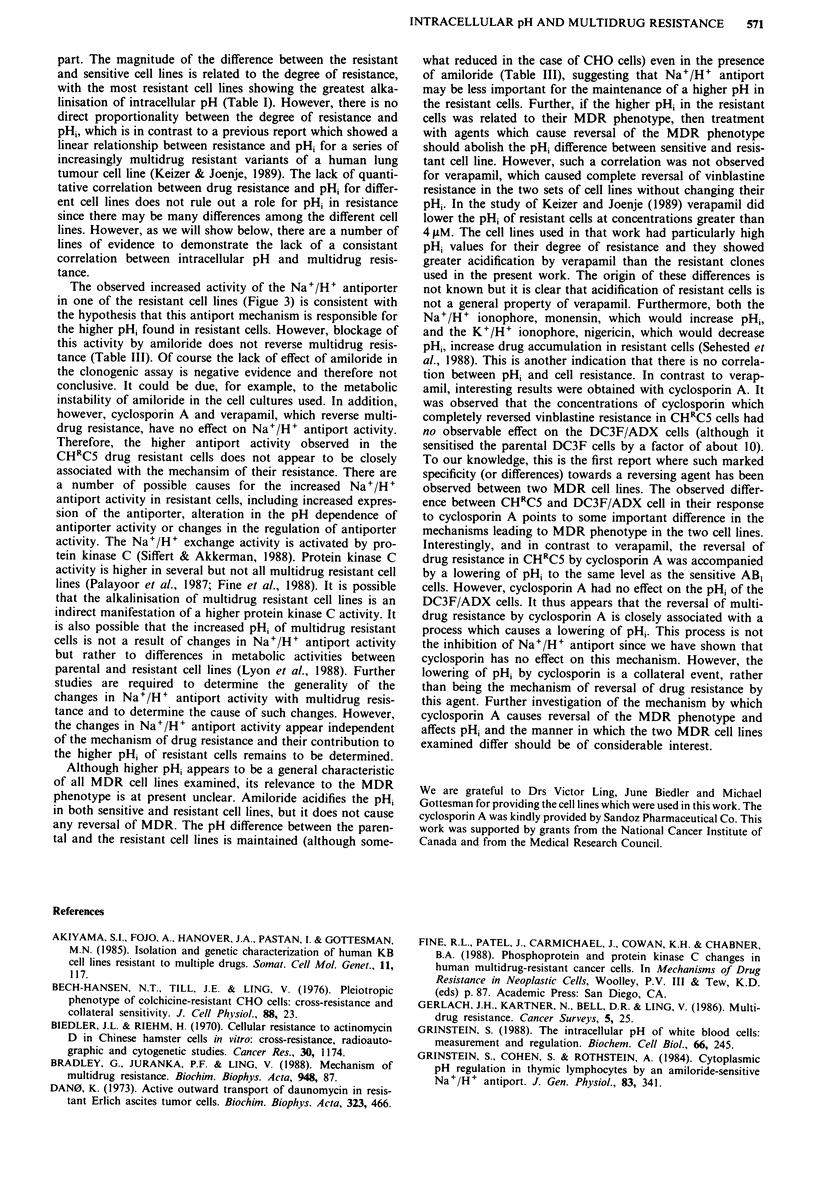Abstract
The intracellular pH of a number of multidrug resistant cell lines was compared with that of their parental lines using the fluorescent probe bis-carboxyethylcarboxyfluorescein. In four different cases, cells having 5-fold resistance or more exhibited an intracellular pH which was 0.10-0.17 units higher than that of the parental cell line. A CHO cell line, AB1, and its 180-fold resistant counterpart, CHRC5, were further investigated with regard to the role of Na+/H+ antiport. The Na+/H+ antiport activity was greater at any intracellular pH for the CHRC5 cells than the AB1 cells. To investigate the possible role of higher intracellular pH in multidrug resistance, the effect of several agents which are either known to reverse multidrug resistance or inhibit Na+/H+ antiport activity were examined. Verapamil was found to reverse multidrug resistance but had no effect on intracellular pH while amiloride, which acidifies the cytoxol by blocking Na+/H+ antiport activity, did not cause reversal of drug resistance. In contrast to verapamil, treatment of CHRC5 cells with cyclosporin A had a parallel effect on reversal of their drug resistant phenotype and a lowering of their intracellular pH to that of the sensitive cell level. However, cyclosporin was ineffective in either lowering the intracellular pH or reversing drug resistance in DC3F/ADX cells. Therefore, except for the effect of cyclosporin A on the CHRC5 line, the effects of other agents on reversal of multidrug resistance and intracellular pH did not correlate with each other.
Full text
PDF




Selected References
These references are in PubMed. This may not be the complete list of references from this article.
- Akiyama S., Fojo A., Hanover J. A., Pastan I., Gottesman M. M. Isolation and genetic characterization of human KB cell lines resistant to multiple drugs. Somat Cell Mol Genet. 1985 Mar;11(2):117–126. doi: 10.1007/BF01534700. [DOI] [PubMed] [Google Scholar]
- Bech-Hansen N. T., Till J. E., Ling V. Pleiotropic phenotype of colchicine-resistant CHO cells: cross-resistance and collateral sensitivity. J Cell Physiol. 1976 May;88(1):23–31. doi: 10.1002/jcp.1040880104. [DOI] [PubMed] [Google Scholar]
- Biedler J. L., Riehm H. Cellular resistance to actinomycin D in Chinese hamster cells in vitro: cross-resistance, radioautographic, and cytogenetic studies. Cancer Res. 1970 Apr;30(4):1174–1184. [PubMed] [Google Scholar]
- Bradley G., Juranka P. F., Ling V. Mechanism of multidrug resistance. Biochim Biophys Acta. 1988 Aug 3;948(1):87–128. doi: 10.1016/0304-419x(88)90006-6. [DOI] [PubMed] [Google Scholar]
- Dano K. Active outward transport of daunomycin in resistant Ehrlich ascites tumor cells. Biochim Biophys Acta. 1973 Oct 25;323(3):466–483. doi: 10.1016/0005-2736(73)90191-0. [DOI] [PubMed] [Google Scholar]
- Gerlach J. H., Kartner N., Bell D. R., Ling V. Multidrug resistance. Cancer Surv. 1986;5(1):25–46. [PubMed] [Google Scholar]
- Grinstein S., Cohen S., Rothstein A. Cytoplasmic pH regulation in thymic lymphocytes by an amiloride-sensitive Na+/H+ antiport. J Gen Physiol. 1984 Mar;83(3):341–369. doi: 10.1085/jgp.83.3.341. [DOI] [PMC free article] [PubMed] [Google Scholar]
- Grinstein S. The Ayerst award lecture 1987/La Conférence Ayerst 1987. The intracellular pH of white blood cells: measurement and regulation. Biochem Cell Biol. 1988 Apr;66(4):245–249. doi: 10.1139/o88-032. [DOI] [PubMed] [Google Scholar]
- Gupta R. S. Intrinsic multidrug resistance phenotype of Chinese hamster (rodent) cells in comparison to human cells. Biochem Biophys Res Commun. 1988 Jun 16;153(2):598–605. doi: 10.1016/s0006-291x(88)81137-9. [DOI] [PubMed] [Google Scholar]
- Gupta R. S., Murray W., Gupta R. Cross resistance pattern towards anticancer drugs of a human carcinoma multidrug-resistant cell line. Br J Cancer. 1988 Oct;58(4):441–447. doi: 10.1038/bjc.1988.237. [DOI] [PMC free article] [PubMed] [Google Scholar]
- Gupta R. S. Taxol resistant mutants of Chinese hamster ovary cells: genetic biochemical, and cross-resistance studies. J Cell Physiol. 1983 Jan;114(1):137–144. doi: 10.1002/jcp.1041140122. [DOI] [PubMed] [Google Scholar]
- Inaba M., Watanabe T., Sugiyama Y. Kinetic analysis of active efflux of vincristine from multidrug-resistant P388 leukemia cells. Jpn J Cancer Res. 1987 Apr;78(4):397–404. [PubMed] [Google Scholar]
- Keizer H. G., Joenje H. Increased cytosolic pH in multidrug-resistant human lung tumor cells: effect of verapamil. J Natl Cancer Inst. 1989 May 3;81(9):706–709. doi: 10.1093/jnci/81.9.706. [DOI] [PubMed] [Google Scholar]
- Lyon R. C., Cohen J. S., Faustino P. J., Megnin F., Myers C. E. Glucose metabolism in drug-sensitive and drug-resistant human breast cancer cells monitored by magnetic resonance spectroscopy. Cancer Res. 1988 Feb 15;48(4):870–877. [PubMed] [Google Scholar]
- Palayoor S. T., Stein J. M., Hait W. N. Inhibition of protein kinase C by antineoplastic agents: implications for drug resistance. Biochem Biophys Res Commun. 1987 Oct 29;148(2):718–725. doi: 10.1016/0006-291x(87)90935-1. [DOI] [PubMed] [Google Scholar]
- Rink T. J., Tsien R. Y., Pozzan T. Cytoplasmic pH and free Mg2+ in lymphocytes. J Cell Biol. 1982 Oct;95(1):189–196. doi: 10.1083/jcb.95.1.189. [DOI] [PMC free article] [PubMed] [Google Scholar]
- Sehested M., Skovsgaard T., Roed H. The carboxylic ionophore monensin inhibits active drug efflux and modulates in vitro resistance in daunorubicin resistant Ehrlich ascites tumor cells. Biochem Pharmacol. 1988 Sep 1;37(17):3305–3310. doi: 10.1016/0006-2952(88)90643-0. [DOI] [PubMed] [Google Scholar]
- Siffert W., Akkerman J. W. Protein kinase C enhances Ca2+ mobilization in human platelets by activating Na+/H+ exchange. J Biol Chem. 1988 Mar 25;263(9):4223–4227. [PubMed] [Google Scholar]
- Thomas J. A., Buchsbaum R. N., Zimniak A., Racker E. Intracellular pH measurements in Ehrlich ascites tumor cells utilizing spectroscopic probes generated in situ. Biochemistry. 1979 May 29;18(11):2210–2218. doi: 10.1021/bi00578a012. [DOI] [PubMed] [Google Scholar]


